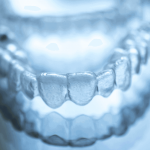An Introduction to Orthodontics Appliances

Orthodontics use a wide variety of appliances to correct crooked teeth and misaligned jaws — most commonly in children but not exclusively so. Parents should take their children to see an orthodontist for an assessment of their dental development at approximately age seven. An orthodontist will examine your child’s teeth, gums and jaw carefully and may take dental images to project the future development and growth of their permanent teeth, jaw and future wisdom teeth. If potential future issues are observed, your orthodontist may develop a treatment plan to start right away or at a future stage in your child’s development, or simply establish a watch-and-see routine to ensure things stay on track.
Contemplating a child’s need for orthodontics in Irvine is a stressful issue for parents on several fronts. First, no one wants to imagine their child having to go through medical treatment that may frighten them or make them uncomfortable. Second, orthodontic work can be expensive and take a long time to accomplish. As a result of these twin concerns, many parents have many questions about orthodontics appliance options near you. Let’s try to answer a few of them.
What are “orthodontic appliances?”
Orthodontic appliances are the devices used to influence the development of your child’s teeth and jaw over time and to correct issues that have emerged or threaten to do so. While braces for kids in Irvine CA are the most common and familiar type of appliance, they’re not the only one. Here are some of the common appliances used and a brief explanation of each.
Braces apply pressure to and move teeth through arch wires connected to brackets bonded to your child’s teeth. Traditionally, braces for kids near you have been made of stainless steel, but there are several different options available today, including ceramic brackets, plastic materials, nickel-titanium and copper-titanium wires and a combination of steel and those alternatives.
Aligners are devices similar to trays and mouthguards that slip over the top of the teeth in the upper and/or lower jaw. They’re almost entirely transparent and removable and move teeth by the slight differences between successive sets of retainers shaped for your child’s teeth through digital scans. Invisalign may be appropriate for mature teens, but is not appropriate for younger children.
Temporary anchorage devices (TADs) are small screws (from six to 12 mm long and 1.2 to two mm thick). TADS screwed into bone provide temporary fixed points to which other appliances can be connected to apply predictable and targeted pressure.
Rubber bands come in every colour imaginable and give kids the chance to customize the appearance of their mouth while undergoing orthodontic treatment according to mood, season or whim. Rubber bands exert subtle but persuasive force to move teeth to their required position in addition to the pressure imposed by the primary appliance.
Headgear is an appliance that is attached to braces with an elastic strap that wraps around the back of a child’s head. Like rubber bands, headgear imposes additional pressure to move teeth in concert with the pressure imposed by the braces. Typically, headgear is only worn at night or at home so that kids don’t have to wear it at school or when out with friends. Braces can be stigmatizing enough without having to wear headgear in public, let’s face it.
Retainers are worn after the main work of an orthodontic treatment plan is accomplished. Retainers retain the teeth’s new positions. Their goal is not to move the teeth, but to maintain the teeth in their new positions while resisting the teeth’s natural urge to shift into familiar former locations.
Each of these appliance options comes with advantages and disadvantages that make them appropriate for some — but not all — teeth alignments. Your orthodontist with complete knowledge of your child’s current teeth and jaw and insight into the ongoing development of your child’s future teeth will be able to recommend the most appropriate appliance option(s).
Dentists understand that orthodontic treatment is a stressful proposition for all involved and are committed to making orthodontic treatment as comfortable, efficient and accessible as possible for all. Our best advice when it comes to dealing with the potential stress of orthodontics near you is to not ignore the possible need for treatment, but to investigate that possibility as soon as possible — when your child is approximately seven. Early investigation and intervention will help your dentist to help your child develop straight teeth for a lifetime while treatment is as simple, quick, inexpensive and comfortable as possible.














